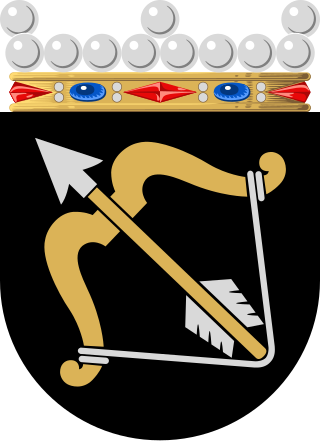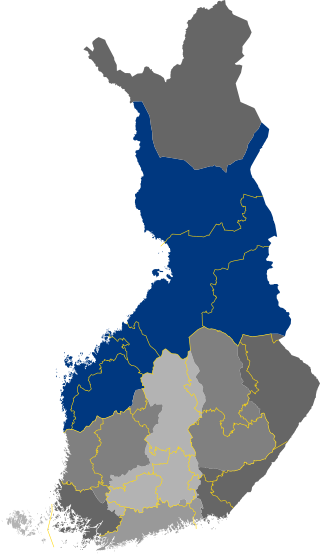
The provinces of Sweden are historical, geographical and cultural regions. Sweden has 25 provinces; they have no administrative function, but remain historical legacies and a means of cultural identification as pertains, for example, to dialects and folklore.

Finland Proper or Southwest Finland is a historical province in southwestern Finland, administered by its historic capital of Turku. It borders Satakunta, Tavastia, and Uusimaa. It is also bounded by the Baltic sea facing Åland. There was also a modern region by the name Finland Proper.

Tavastia is a historical province in the south of Finland. It borders Finland Proper, Satakunta, Ostrobothnia, Savonia and Uusimaa.

Uusimaa is a historical province in the south of Finland. It borders Finland Proper, Tavastia, Savonia, and Karelia. The English translation would be "new land". From the Middle Ages to 1809, most of the present-day Finland was a part of Sweden. Uusimaa (Nyland) was thus also included among the historical Swedish provinces.

Savonia is a historical province in the east of Finland. It borders Tavastia, Ostrobothnia and Karelia. Savonia is now divided into two provinces: North Savonia and South Savonia. The largest cities in Savonia by population are Kuopio, Mikkeli, Savonlinna, Varkaus and Iisalmi.

Ostrobothnia, Swedish: Österbotten, Finnish: Pohjanmaa is a historical province comprising a large western and northern part of modern Finland. It is bounded by Karelia, Savonia, Tavastia and Satakunta in the south, the Bothnian Sea, Bothnian Bay and Swedish Westrobothnia in the west, Laponia in the north and Russia in the east.

The historical provinces of Finland are a legacy of the country's joint history with Sweden. The provinces ceased to be administrative entities in 1634 when they were superseded by the counties, a reform which remained in force in Finland until 1997. The provinces remain as a tradition, but have no administrative function today. The spread of Finnish language dialects approximately follows their borders.

Öland is a province of Sweden and, like many of Sweden's provinces, was granted a coat of arms in preparation for the funeral of Gustav Vasa in 1560. Confusion arose between Öland's arms with one deer and Åland's arms with two deer and nine roses, resulting in Öland bearing the wrong coat of arms from the 1880s until an audit in 1944.

Joensuu is a city and municipality in North Karelia, Finland, located on the northern shore of Lake Pyhäselkä at the mouth of the Pielinen River (Pielisjoki). It was founded in 1848 by Russian Emperor Nicholas I. The population of Joensuu is 77,958, and the economic region of Joensuu has a population of 115,000. It is the 12th largest city in Finland. The nearest major city, Kuopio in North Savonia, is located 136 kilometres (85 mi) to the west. From Joensuu, the distance to Lappeenranta, the capital of South Karelia, is 233 kilometres (145 mi) along Highway 6.

Three Crowns is the national emblem of Sweden, present in the coat of arms of Sweden, and composed of three yellow or gilded coronets ordered two above and one below, placed on a blue background. Similar designs are found on a number of other coats of arms or flags.

The coat of arms of Åland features a golden red deer on a blue field. This is traditionally surmounted by a comital coronet of the elder Swedish style.

Karelia is a historical province of Finland, consisting of the modern-day regions of South Karelia and North Karelia. Historical Karelia also extends to the regions of Kymenlaakso, Northern Savonia and Southern Savonia (Mäntyharju).

Karelia is an area in Northern Europe of historical significance for Russia, Finland, and Sweden. It is currently divided between northwestern Russia and Finland.

Satakunta is a region of Finland, part of the former Western Finland Province. It borders the regions of Southwest Finland, Pirkanmaa, South Ostrobothnia and Ostrobothnia. The capital city of the region is Pori. The name of the region literally means hundred. The historical province of the same name was a larger area within Finland, covering modern Satakunta as well as much of Pirkanmaa.

The coat of arms of Finland is a crowned lion on a red field, the right foreleg replaced with an armoured human arm brandishing a sword, trampling on a sabre with the hindpaws. The coat of arms was originally created around the year 1580.

Pomian is a Polish coat of arms. It was used by several szlachta families in the times of the Polish–Lithuanian Commonwealth.

The coat of arms of the Russian Republic of Karelia is crossed in three equal parts with the colors of the flag of Karelia on a shield with a profile of a rampant black bear. The golden frame of the shield comes into stylized image of a fir tree on the left and a pine tree on the right. In the upper part of the shield there is an octagonal star of gold. The arms were created by Yu. S. Nivin.

A crown is often an emblem of a sovereign state, usually a monarchy, but also used by some republics.

The bear as heraldic charge is not as widely used as the lion, boar or other beasts.

A scimitar is a single-edged sword with a convex curved blade associated with Middle Eastern, South Asian, or North African cultures. A European term, scimitar does not refer to one specific sword type, but an assortment of different Eastern curved swords inspired by types introduced to the Middle East by Central Asian ghilmans. These swords include the Persian shamshir, the Arab saif, the Indian talwar, the North African nimcha, and the Turkish kilij. All such swords are originally derived from earlier curved swords developed in Turkic Central Asia (Turkestan).























